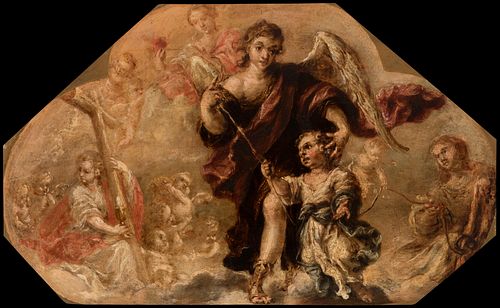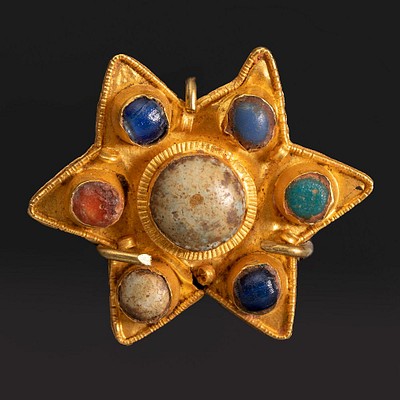JUAN DE VALDÉS LEAL (Seville, 1622 - 1690). "The guardian angel". Oil on panel. Cradled.
Lot 66
About Seller
Setdart Auction House
Carrer Aragó 346
Barcelona
Spain
Setdart Subastas was born in 2004 and is currently the first online art auction in Spain with solidity, prestige and reliability guaranteed by our more than 60,000 users. Setdart has a young, dynamic and enterprising team ready to successfully manage the purchase and sale of art works through custom...Read more
Estimate:
EUR€85,000 - EUR€100,000
$91,397.85 - $107,526.88
Absentee vs Live bid
Two ways to bid:
- Leave a max absentee bid and the platform will bid on your behalf up to your maximum bid during the live auction.
- Bid live during the auction and your bids will be submitted real-time to the auctioneer.
Bid Increments
| Price | Bid Increment |
|---|---|
| EUR€0 | EUR€10 |
| EUR€200 | EUR€25 |
| EUR€500 | EUR€50 |
| EUR€1,000 | EUR€100 |
| EUR€3,000 | EUR€200 |
| EUR€5,000 | EUR€500 |
| EUR€10,000 | EUR€1,000 |
| EUR€20,000 | EUR€2,000 |
| EUR€50,000 | EUR€5,000 |
About Auction
By Setdart Auction House
Dec 21, 2021
Set Reminder
2021-12-21 07:30:00
2021-12-21 07:30:00
America/New_York
Bidsquare
Bidsquare : Córdoba: 2,000 Years of Art
https://www.bidsquare.com/auctions/setdart-auction-house/c-rdoba-2-000-years-of-art-8049
Setdart Auction House sofia@setdart.com
Setdart Auction House sofia@setdart.com
- Lot Description
JUAN DE VALDÉS LEAL (Seville, 1622 - 1690). "The guardian angel". Oil on panel. Cradled. Measurements: 50 x 78 cm; 60 x 88 cm (frame). The religious painting of Valdés Leal stood out for its use of complex compositions, variegated of characters as in this particular case. Although a pyramidal structure can be appreciated in the center, which facilitates the reading of the scene, the author places several figures at both ends and in deeper planes, which turns the religious image into a representation full of dynamism and expressiveness. In the center, the figure of the Child Jesus is represented, accompanied by the Guardian Angel, who holds his hand and seems to guide him. In Christianity, the guardian angel would be the one that God has appointed to each person to protect him. Hence, he is usually represented as a guide for life understood as a path, as is the case here. The fact that the sculptor has represented the faithful with the figure of a child emphasizes even more this protective role that the guardian angel fulfills with respect to the defenseless Christian soul. Formally it is a work halfway between Mannerism and Baroque, although at first sight the dynamism and expressive force of the latter style dominates. However, the anatomy of the angel refers to models of Michelangelo, a key reference for the artists of Mannerism. Thus, it is a strong, muscular character with great presence, endowed with a certain idealization and far from the realistic canons of the Baroque. Valdés Leal worked, however, on all kinds of religious themes. We do not know at what date he moved to Cordoba, although it is foreseeable that he had already received his first artistic training in his native city. It has been speculated that he was close to the workshop of Herrera el Viejo, and also to the art of the Cordovan Antonio del Castillo, as possible influences for his first known signed and dated work, the San Andrés de la iglesia de San Francisco de Córdoba, from 1647. In it he combined with visible success the monumentality of the figure of the saint with a naturalistic approach. In 1656 he settled in Seville, where he spent most of his life. In 1660 he was one of the founders of the Academy of Drawing, of which he became president in 1663. The following year Palomino established his trip to the court and to El Escorial, a journey that can still be understood as an apprenticeship, driven by his eagerness to know the works of the great masters present in the royal collections. In 1667 he joined the Brotherhood of Charity of Seville, whose founder had been Miguel de Mañara, the noble visionary author of the eschatological Discourse of Truth, to which Valdés would remain attached from then on. In 1671, Valdés Leal had the opportunity to work as an architect on the ephemeral decorations that the cathedral of Seville had installed to celebrate the canonization of Saint Ferdinand. Thanks to these works Palomino defines him as "a great draftsman, perspective and architect". He also made two engravings, reproducing his works in the cathedral, for Fernando Torres Farfán's book celebrating this event, which gives us an insight into his work as an architect. These are his most important works as a printmaker, although his engraving of the cathedral monstrance, a self-portrait and the posthumous image of Miguel de Mañara are also known. In 1672 he was in Cordoba, an occasion that Palomino took advantage of to meet him personally. This gives more value to the affirmation of the Cordovan treatise writer on the literary interest of Valdés Leal, because he makes him possess "the ornament of all the good letters, without forgetting those of poetry".
- Shipping Info
-
In-house shipping available. Please inquire at admin@setdart.com.
-
- Buyer's Premium



 EUR
EUR CAD
CAD AUD
AUD GBP
GBP MXN
MXN HKD
HKD CNY
CNY MYR
MYR SEK
SEK SGD
SGD CHF
CHF THB
THB
















